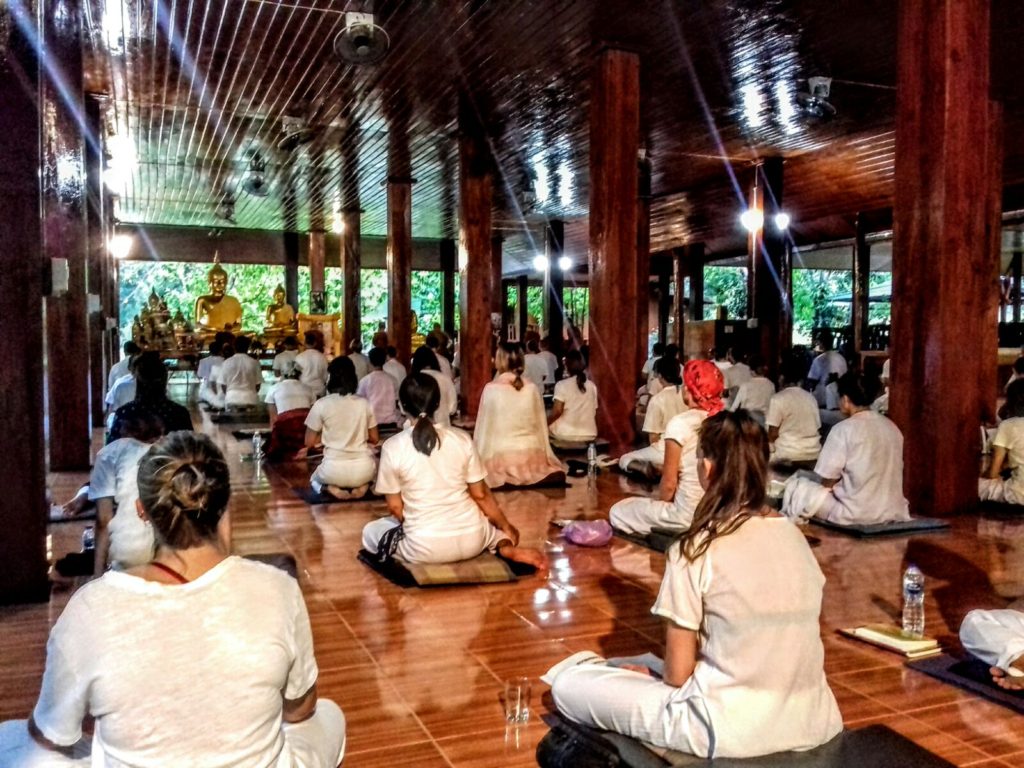 There are two main types of mindfulness meditation, Samadhi (also referred to as Samatha) and Vipassana. These two types of meditation work in conjunction with one and other to bring the individual towards tranquility and the highest, absolute wisdom. Samadhi is concentration meditation. It is the type of meditation in which the individual is completely focused on one object. The aim is that the object and the mind become one. By focusing on the object with complete concentration, the mind becomes still. The object could be the flame of the candle, one’s own breath, or the posture of the body. A favorite tip given was to observe the object with happiness. However, the mind should still hold the object gently and with neutrality.
There are two main types of mindfulness meditation, Samadhi (also referred to as Samatha) and Vipassana. These two types of meditation work in conjunction with one and other to bring the individual towards tranquility and the highest, absolute wisdom. Samadhi is concentration meditation. It is the type of meditation in which the individual is completely focused on one object. The aim is that the object and the mind become one. By focusing on the object with complete concentration, the mind becomes still. The object could be the flame of the candle, one’s own breath, or the posture of the body. A favorite tip given was to observe the object with happiness. However, the mind should still hold the object gently and with neutrality.
“The ultimate benefit of concentration is cleansing out the Five Hindrances, which constrict our mental processes. The Five Hindrances are: ill will, sensual desire, sloth and torpor, distraction or restlessness, and doubtfulness.”
Vipassana meditation is also deemed insight meditation. The purpose of Vipassana is to know the truth of our own life, our own mind, and our own body. In Vipassana, the individual observes everything that happens in his or her mind without judgement or interference. The key is to observe and not react, to not get lost in the thought itself. To not get involved, a state of distance must be rendered. The “thinker” and the “knower” are separate in the mind. As abstract as it sounds, when there is thought there is also a witness. Focus on being the witness of your own thoughts. Our natural reaction is to engage with the thought rather than observe it. As if the mind was a river, our instinct is to jump into current. With meditation we practice to stay on the shore. Of course, it takes practice. And a moments success when we remember, “Oh, I am thinking!” Is a moment to celebrate and then let the thought go as if were a balloon and you were releasing the string. Let it go and return to the breath and mental stillness.

When practicing Vipanassa, be mindful of the body (Samadhi of Kayanupassana). If focusing on breathing in and breathing out is not enough, then focus on the qualities of the breath as long, short, rough, deep, or airy. Note each breath. If additional mental attention is required, say to yourself, “Bud” as you breath in, and “dho” as you breath out. “Bud dho” is Pali for Buddha, the enlightened one. After that feels comfortable, practice being “the knower” and observe your thoughts as they come and go without controlling or judging them. Consciousness needs to be firm and neutral, impassive and unintentional mindful. The breath is in the background and the focus on the Mind is in the foreground. We observe both things. When the mind attached to a thought, we observe it and come back to the breath. We can say internally, “Thinking,” and come back to the breath. Repeating again and again as thoughts arise. In regards to being the “knower,” the mind knows and the breath is known. The thoughts are not “I” and not the self, they are separate from the true self: the knower. The Chanting Book relates that: “the knower, the awakened one is the one that is stable…. rooted in awareness; it is not attached to phenomena and doesn’t slip down into them. It also doesn’t get lost in liking or disliking what arises. It is impartial, unbiased, equanimous.”
There are two so-called “assistants” that need to be developed to aid in meditation. The first assistant is sati (mindfulness) and the second is sampajañña (clear comprehension). Mindfulness is not a product of controlling the mind. Mindfulness will come if there is cause for it to come. Wat Pa Tam Wua’s Chanting Book states:
“Mindfulness will arise if the cause for it to arise is present. The reason mindfulness arises is because of a phenomenon (physical, mental, or emotional state) is well remembered. It is well remembered when we practice recognizing the state often. So we need to watch the mind often. We choose a home base, watch the mind move, and recognize what it does. When the phenomenon is well-remembered, mindfulness will arise on its own to notice the mind has gone of even if it does so for just an instant. Mindfulness arises by remembering phenomena well, not by commanding it to. This is the practice of Vipassana.”






